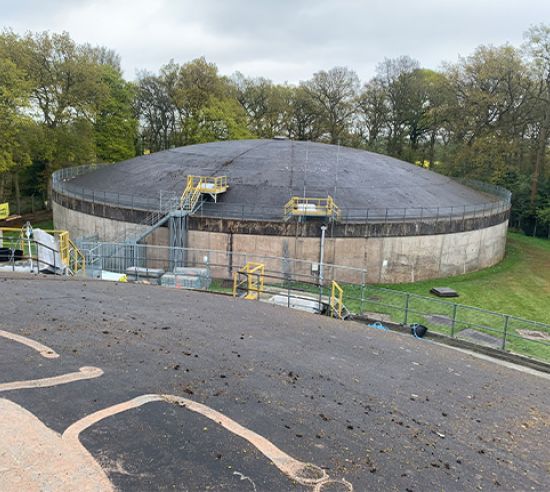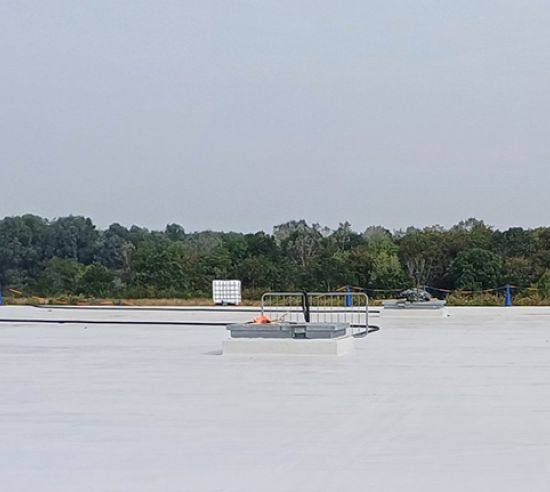Introduction
Contact tanks are critical to water treatment as part of the process of producing drinking water. Here the chlorine disinfection process takes place, integral to water quality. Maintaining the condition and functionality of the contact tanks is therefore key to ensuring the continuation of safe drinking water.
The contact tanks at a reservoir in the midlands had a roof construction of concrete with a failing coating and a top dressing of chippings. For continued operation the contact tanks required a roof refurbishment in order to safeguard the water processing.
The challenge
To mitigate risks of the existing failing coating, a temporary roof was created over the structure. This enabled operational activity to continue whilst remedial works were undertaken.
The existing limestone chippings were originally placed on top to help reduce solar gain and to help protect the underlying waterproofing coating from UV damage. Once these chippings were removed, the current waterproofing coating was found to be delaminating which meant that the concrete substrate underneath was exposed. Any cracks in the concrete poses significant risk of water ingress, carbonation and resultant steel rebar corrosion leading to structural damage.
The existing 2000m² contact tank flat roof also had evidence of ponding water which needed to be addressed. Ponding water in this environment can not only cause a slippery surface for maintenance personnel, but also risks algae growth and raises hygiene concerns.
A replacement waterproofing and protection system was required that was lightweight and offered high crack bridging capabilities to address any future movement in the contact tank’s roof. In addition, the roof incorporates hatches and other details for considered waterproofing. The site was to remain live throughout, so a rapid installation was sought for minimal disruption.
The solution
Triflex UK worked with Triflex Authorised Contractor, Waterlines solutions, to provide a robust system that could be quickly and easily installed on this live site. Triflex technical services team assessed the existing roof build up and surface to ensure the most appropriate waterproofing system. The team conducted a number of tests to ensure the correct preparation and pretreatment was provided for a proposed Triflex system. Tests included adhesion and cohesive strength testing for proven performance of the system bond to the concrete substrate considering wind uplift.
The Triflex ProTect fully reinforced system in a light grey (RAL 7035) was proposed. The lightweight and self-terminating solution provides outstanding waterproofing, and is rainproof in just 30 minutes. The cold liquid applied PMMA waterproofing system is flexible and certified to EN 1504-2: B4.2 (-20°C) dynamic crack bridging for the protection of concrete structures. For the details and upstands, the same colour way Triflex ProDetail system was proposed. This provided reinforced waterproofing for the more complex areas such as the access hatches. The thixotropic formulation means that it can be used on vertical surfaces straight from the drum. For very tricky details, such as hatches positioned against an upstand, Triflex ProFibre offered a practical solution. Triflex ProFibre incorporates reinforcing fibres within our unique solvent free resin technology, enabling rapid waterproofing of even the most complex details.
The existing coating was removed back to the concrete substrate by grinding. Whilst Triflex systems have been successfully used to overlay thousands of substrates, in this instance the current coating was beyond repair. Its removal negated any risk of the existing coating failing to bond to the primary substrate. As part of the Triflex system installation, any cracks in the concrete roof were also overbanded with the reinforced system providing long term protection and peace of mind.
The ponding of the roof was also addressed during the refurbishment with the innovative Triflex ProScreed. The contact tanks roof is a duo fall roof with 1:60 falls. Once the existing coating was removed, the reprofiling of the existing roof was undertaken. This was achieved with PMMA-based Triflex ProScreed. The water free, screeding and repair mortar meant that minor falls could be reprofiled quickly. The exceptionally fast curing mortar can overlay and repair cementitious substrates without delaying works. Here, crickets were also formed with Triflex ProScreed, in addition to mitering a fall between outlets to ensure effective water run-off.
The Triflex ProTect light grey colour was chosen to help reduce solar gain, since it’s lighter colour will reflect more sunlight and the roof surface will stay cooler than darker surfaces. As the Triflex ProTect PMMA based system is UV stable, it will not be affected by prolonged UV exposure. Consequently, the roof no longer required heavy chippings too, which had hid defects in the past.
The Contact Tank roof area incorporated an anti-skid finish, improving the safety for access for personnel to undertake inspection and with an easy to clean surface, improved maintenance procedures.
The Triflex waterproofing systems rapidly cure in low temperatures, down to -5°C at the details. This meant the installation of the systems could take place in the winter months with confidence, even in this exposed location. The installation was carried out to a high standard, supported by Triflex on site and off site technical services.








